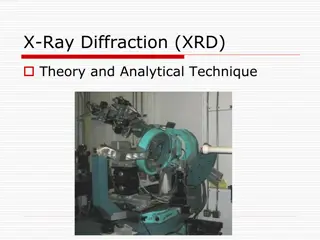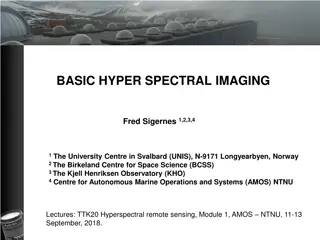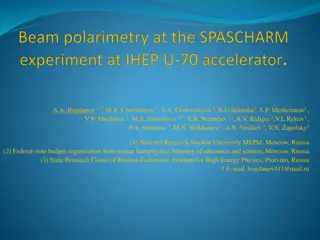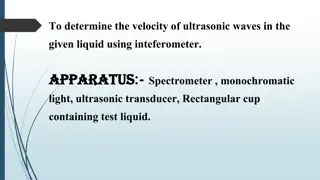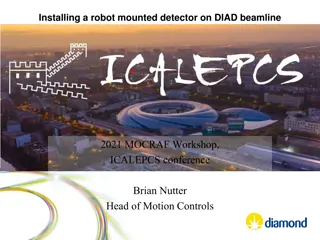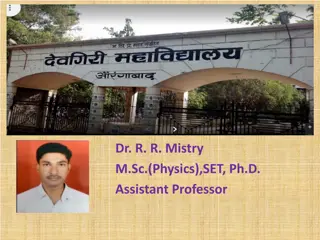Understanding Diffraction and Determination of Track Spacing on CDs and DVDs
Explore the phenomena of diffraction and how it relates to the colorful patterns on CDs and DVDs. Learn about diffraction gratings, He-Ne lasers, and the technology behind Compact Discs. Discover how to determine track spacing using principles of diffraction.
Download Presentation

Please find below an Image/Link to download the presentation.
The content on the website is provided AS IS for your information and personal use only. It may not be sold, licensed, or shared on other websites without obtaining consent from the author. Download presentation by click this link. If you encounter any issues during the download, it is possible that the publisher has removed the file from their server.
E N D
Presentation Transcript
DETERMINATION OF TRACKSPACING ON CDS AND DVDS USING THE PRINCIPLES OF DIFFRACTION S V HAREENDRAKUMAR ASSOCIATE PROFESSOR PG DEPARTMENT OF PHYSICS
We all noticed the colourful patterns reflecting from the shiny surface of a CD disc. Actually what we are seeing is the diffraction of white light and the rainbows of colors are diffraction patterns. In this project, we will learn about how the diffraction patterns are generated, and we will find out microscopic spacing of data tracks on a CD as well as DVD using a laser pointer.
DIFFRACTION Diffraction refers to various phenomena that occur when a wave encounters an obstacle or a slit. It is defined as the bending of waves around the corners of an obstacle or aperture in to the region of geometrical shadow of obstacle. In classical physics the diffraction phenomenon is described as the interference of waves according to the Hygens - Frensel principle that treats each point in the wave front as a collection of individual spherical wavelets. These characteristic behaviors are exhibited when a wave encounters an obstacle or slit that is comparable in size to its wavelength.
DIFFRACTION GRATING A diffraction grating is an optical element that divides light composed of lots of different wavelengths into light components by wavelength. When white light enters the grating, the light components are diffracted at angles that are determined by the respective wavelengths white light can be separated in to all seven major colors of the complete spectrum or rainbow by using a diffraction grating or a prism .
He Ne Laser Gas lasers are the most widely used lasers. In gases, the energy levels of atoms involved in the lasing process are narrow and as such require sources with sharp wavelength to excite atoms. The most common method of exciting gas laser medium is by passing an electric discharge through the gas. Electrons present in the discharge transfer energy to atoms in the laser gas by collisions.
CD (Compact Disc) The Compact Disc was invented by Sony and Philips in 1981 in order to serve as a high-quality compact audio storage device which allowed for direct access to digital sound tracks. A CD is an optical disc 12cm in diameter and 1.2mm thick for storing digital information: up to 650 MB of computer data (equivalent to 300,000 typed pages) or 74 minutes of audio data. A circular hole 15mm in diameter is used to centre it on the CD player's surface A CD is built from a plastic (polycarbonate) substrate and a fine, reflective metallic film (24-carat gold or a silver alloy). The reflective layer is then covered with an anti-UV acrylic finish, creating a protective surface for data. The reflective layer contains tiny bumps. When the laser passes over the polycarbonate substrate, light is reflected off the reflective surface, but when the laser reaches a bump, that's what allows it to encode information. This information is stored in 22188 tracks engraved in grooves .
DVD(Digital Versatile Disk) In 1995, new standard was established for DVD Digital Versatile Disk. They were first developed for storing a full digital movie. The DVD is a special disk that can store up to 4.7 GB information on a single layer on the disk. The new devices can store information on both sides, so the total amount of information is 9.4 GB. The size of the DVD is the same as CD, but because it uses a shorter wavelength, the pits can be smaller and so is the distance between tracks. DVD devices are based on Diode laser with red wavelength of 650 nm. DVD increases its capacity by using higher resolution optics. DVD uses a shorter wavelength laser with red light around 650 nm compared to a CD with infrared light at 780 nm. In addition, better focusing optics allows closer tracks and smaller pits.
Theory: Utilizing Huygens' Principle, which is that every point on a wave front acts like a new source, each transparent slit becomes a new source so cylindrical wave fronts spread out from each. These wave fronts interfere either constructively or destructively depending on how the peaks and valleys of the waves are related. If a peak falls on a valley consistently (called destructive interference), then the waves cancel and no light exists at that point. On the other hand, if peaks fall on peaks and valleys fall on valleys consistently (called constructive interference), then the light is made brighter at that point. n =dsin DIFFRACTION GRATING EQUATION To find measure distance from grating to screen and the first order distance and then by using trigonometry calculate the angle = tan-1(x/D)
OBSERVATION: DIFFRACTION PATTERN DIFFRACTION IMAGE
The average data track spacing on the DVD was 766 nm and the average track spacing on the CDs was 1532 nm. This makes the data track spacing of the DVD exactly half of the data track spacing of the CDs.




